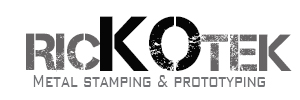When using presses with heavy tonnage to stamp metal into any number of useful forms, the process creates burrs.
These anomalies can be presented as rough or raised areas on the surface of the metal or as ragged sharp edges.
Generally, metal stamping specifications have a burr allowance of 10% of the thickness of the metal material.
Nevertheless, more precise parts may require that these burrs are eliminated with a more complex stamping process or with the use of special deburring techniques applied after the stamping.
A metal stamping engineer can provide insights on how to best address the expected burr, the impact it may have on part tolerances, the design needed to meet specifications, and the best method of deburring if needed.
A Few Important Reasons for Choosing the Right Deburring Process
Customized metal stamping of copper, brass, or steel is the most common types that require deburring a proper finish.
According to the guidelines laid down by the Precision Metal forming Association (PMA), “Deburring is often done for these three main reasons:
1. for safe handling (during manufacturing and in-service)
2. to avoid abrasive/cutting effects (for example, on adjacent components)
3. to improve surface appearance
“Some other reasons for deburring include removing the discoloration caused by brazing and welding. Deburring also removes unwanted contaminants, rust, oxidation, or scale from heat treatment,” says PMA.
If a part has a burr that creates a sharp edge, this could cause problems handling the part or performance errors when in use.
Most of the deburring the stampers do on stampings is to meet precision specifications for a radius edge or an edge break. most stamped parts will require deburring come in all sizes from very small to 16X6”.
How Deburring is Working
When handling large quantities of stamped metal parts in a single deburring process, the barrel and vibratory finishing are favored. These use a tumbling or vibratory action through an abrasive media and cleaning solution to remove burrs.
Another option is electro-polishing which can be used for micro deburring very small parts, but it is a costly operation.
The barrel and vibratory finishing processes also remove oils and any other foreign contaminants as well as rough edges and burrs. Electro-polishing can remove surface metals and create a smooth mirror-like surface.
BARREL DEBURRING
Barrel deburring can be used to address many parts at one time but they must be sturdy and solid. This process works by parts contacting other parts in a large tub. As the tub rotates the burrs are eliminated.
VIBRATORY DEBURRING
More delicate stampings can be deburred in an oscillating channel in the vibratory deburring process.
“The deburring media applied here will have to be suitable to the configuration of the part and the metal material,” says Polte. “It can also range in size from small BB-sized pellets to stones two-inches in diameter.”
Some of the deburring media types most commonly used include:
•Corn cobs ground to the consistency of sawdust
•Plastic
•Ceramic
• Aluminum oxide, a gritty abrasive powder
•Stone
ELECTROPOLISHING
Electro-polishing works to remove a thin outer layer of the metal as well as any contaminants. This occurs when the metal parts are immersed in a blended chemical electrolyte bath and connected to an electrical current.
It is the preferred method of deburring for especially small or intricate stampings. If these were placed in a barrel or vibratory deburring process their structural integrity could be affected. During the electro-polishing process, the transfer of ions takes place most rapidly at the corners and edges.
This is because the concentration of electrical power is greatest at high points which is why lightning is drawn to the tallest features of the environment.
This also explains why plating builds fastest at the edges and points of the parts. But, electro-polishing will not work well for heavy die-cut or the larger metal burrs.
Commonly Deburred Stamped Metal Parts
•Medical device components
•Terminals
•Washers
•Brackets
Asking for Deburring Recommendations from a Qualified Metal Stamping Engineer
Manufacturers will often specify some type of deburring in the RFQ, you can expect a much more insightful recommendation for addressing burrs from an experienced metal stamping engineer.
Not only will you understand the kind of burrs to expect based on the critical dimensions of the stamping but what type of process will be most effective at removing them.

